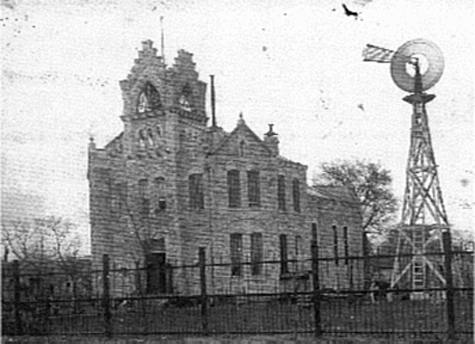 The Fayette County Jail
The Fayette County JailFAYETTE COUNTY, TEXAS
La Grange, Texas was designated as a "Main Street City" by the Texas Historical Commission in January 1996. One of the main goals of the Main Street Program is the revitalization of historic buildings in the downtown area. In order to accomplish such a goal it is vital to know the histories of those buildings.
 The Fayette County Jail
The Fayette County JailIn November 1881, the county commissioners selected the Victorian Gothic design of Andrewarthe & Wahrenberger for a new prison and received the bid of Fritz Schulte for its construction. Tillman Eaves (colored) was paid $1500 to haul rock from Buckner's Creek for use in the outer walls. The building was not completed until mid 1883 at a cost of nearly $30,000. The six foot tall ornamental fence was erected in May 1884. The county used the facility for 102 years until the new justice center was opened in 1985. Ten years later, the building was remodeled and currently houses the offices of the La Grange Chamber of Commerce and Main Street La Grange.
 259 North Main
259 North MainBefore the turn of the century, the Mueller Hotel stood on this site. At the height of its popularity, it consisted of five buildings. Onno Mueller, the owner, died in 1894 and soon after, the hotel was sold.
Charles and Emma Schmidt Kruschel bought the property. In 1899, Mr. Kruschel died.
In 1907, Mrs. Kruschel accepted the plans of architect L. F. Kruschel for a modern two story residence on her property. The new home would contain 11 rooms, a winding porch and be equipped with all modern conveniences. The cost would be about $4,100. Construction began in October 1907 and was finished later that year or in early 1908. One of the Kruschel's children was disabled, so an elevator was installed in the home and was operated by a pulley and ropes, but was later modernized with an electric motor.
The Kruschel family owned the property until 1979, when it was sold to the present owners, Arnold & Suzy Romberg.
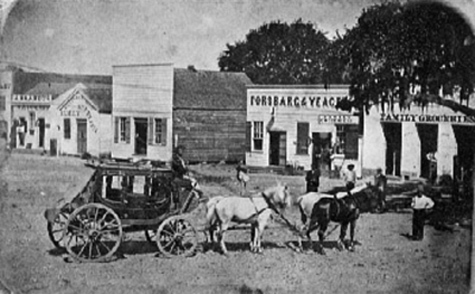 North Side of Square
North Side of Squareca 1865
Risher & Sawyer Stage stopped in front of today's "Historic Oak Treee" on the corner of Washington & Colorado. Forsbarg & Yeager and Family Groceries buildings sit on area now part of La Grange State Bank.
 North Side Square
North Side SquareEarly 1900s
 222 & 226 West Colorado c.1950
222 & 226 West Colorado c.1950August E. Homuth operated his "Favorite Saloon" in a two story structure on part of this site before 1881. In 1885, Mr. Homuth bought the adjoining lot in order to build a new 40 x 95 foot two story brick structure. J. A. Jackson, builder, started work in July 1885. An iron front was chosen for appearance and fire safety and was shipped here from the Pullis Brothers Company of St. Louis, Missouri. The second story of the building was made of cut stone with Allert, Redmond & Fletcher as stone & brick masons. Work had to stop for a week due to a brick shortage. The new building was finished and officially opened just 4 1/2 months later on October 17, 1885. The "Iron Front Saloon" and billiard hall was on the first floor.
A short time later, Mr. Homuth took our a $5,000 loan and converted the second floor into a first class opera house. Woodwork, plastering & a stage and other theatrical paraphernalia was added. The scenery sets were painted by Mr. Koper. Homuth's Opera House was the only place in La Grange to have public entertainments.
Mr. Homuth died in 1891. In 1892, A. C. Lenert was re-modeling the building by putting in a central stairway and partitioning the first floor into two separate rooms. One side housed the saloon and the other side was rented out. The partitions were removed in 1974 when Ben Franklin opened and utilized the entire first floor.
Known businesses: Dancing school; oyster bar & restaurant; Favorite lunch counter; Bickenbach & Gerdes clothing store; Goodman's Dry Goods; Kainer & Gerdes Dry Goods; Davidge's Cash Grocery; George E. Lenert law & insurance office; Southwestern Telephone Exchange; Dietrich & Krengel Jewelry; M. M. Arredondo restaurant; Voelkel-Addicks-Weber Company; Dr. E. C. Schulze; E. J. Weber Insurance; La Grange Buick Company; R. V. Solomon law office; Brewton's Barber Shop; Dippel's Cash Grocery; Dolezal's Barber Shop; Jurasek Hotel; Cash and Carry Grocery Store; Ben Franklin; That's My Style.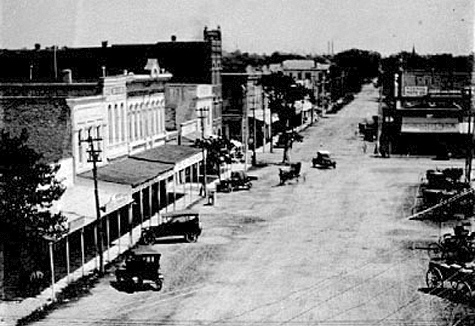 East Colorado Street Looking East
East Colorado Street Looking Eastca 1919
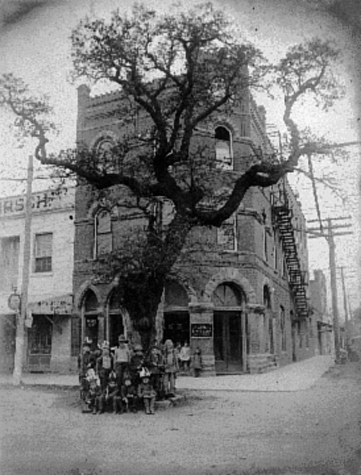 Cowboys and Indians Gathered at the Historic Oak on Colorado Street
Cowboys and Indians Gathered at the Historic Oak on Colorado Streetca 1920
Schumacher Bank Building
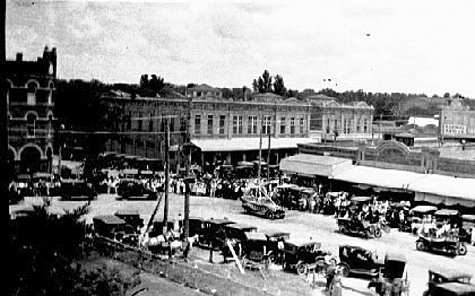 and 220 & 222 North Washington
and 220 & 222 North WashingtonAs early as the 1840's, a frame building stood on this site and served as a hotel under many different names: Eagle Hotel; Carter Hotel; Farquhar Hotel; Peavine Hotel.
In January 1884, the La Grange Building Association, a stock company, bought out the La Grange Hotel. As soon as enough brick could be burned, construction began on a first class hotel in the same place as the old one.
By January 1885, work on the new hotel was progressing and by February, the timbers for the first and second floors were up and the 1st floor studding and brick work was almost complete. The workmen, plasterers and carpenters were hard at work by July and Frank Reichert was assembling and re-varnishing the furniture.
The "Lester House" opened on September 1, 1885 with 25 rooms on the second floor, and hard finished and well ventilated with elegant furnishings and very other convenience. The first floor had space for two businesses, a barber shop, office, dining room and kitchen.
The hotel was still operating in the late 1940s. In the 1970s the second floor contained apartments.
The first floor spaces have been renovated many times over the years and been home to many different businesses. The only space that remained constant since 1885 was the barber shop.
Known businesses at 164 West Colorado: Aaronsohn's Bargain Depot; Bertha Kellersberg, milliner; Corner Drug Store; White & Lunn Drug Store; Lunn & Ehlinger Drug Store; Ehlinger & Richards Drug Store; Ehlinger & Reynolds Drug Store; Hermes Drug Store; Schrimpsher & Schaefer billiard hall; W. C. Taylor billiard hall; Lueders & Lueders Confectionery; "Happy Hour" saloon; Himly & Granville Drug Store; Himly & Marquart Drug Store; Dr. W. E. Kidd, M. D.; O. C. Eckel's Corner Drug Store; Gaertner's Corner Drug Store; Harris-Gaertner Clothing Store; Sports-n-Stuff; Lee Mueller & Associates; Texas State Optical; Bott's Title Insurance Company.
Known businesses at 160 West Colorado: Western Union; Hotel office; American Express; Hotel Lobby; Southwestern Life Insurance; La Grange Chamber of Commerce; Edward D. Jones Investment Firm; Real Estate office.
Known barber shops: Dennis Hans and son Justin Hans; Joe Parma; Henry Munke; Emil Hans; Hans Hesselmeyer; Birdy Schielack; Andy's Barber Shop.
Known businesses at 152 West Colorado: Mrs. Robertson & Alford, milliners; P. T. Carter, jeweler; Mrs. Carter & Wilkins, dressmakers; Will F. Dietrich & George Krengel, jewelry; hotel dining room; Austin Gas Company; Bon Ton Restaurant; Coffee Shop; Stackhouse's Restaurant; Brook's Restaurant; Hill's Old Tyme Restaurant; Short Stop Cafe; China Inn.
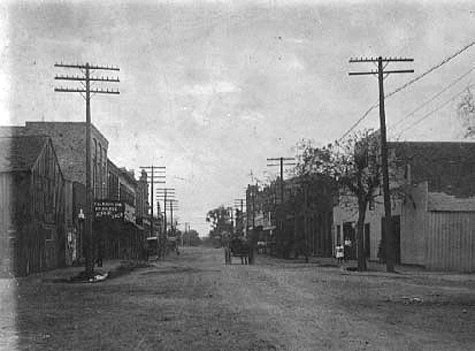 East Colorado Street, looking West
East Colorado Street, looking Westca 1896
 Fayette County Courthouse
Fayette County CourthousePictured circa 1920s
The present and fourth courthouse to grace the downtown square was constructed beginning in January 1891. The chosen architect was famed courthouse designer James Reiley Gordon of San Antonio. The construction contract was given to the firm of martin Byrnes and Johnson, of Colorado City, Texas. The building was completed ahead of schedule, and accepted by the Commissioner's Court on December 1, 1891, at a total cost of $99,407.04. The building was first lit with electricity in February 1892.
The structure is described as a masonry and stone three story Romanesque Revival style building with a 100 foot tall clock tower rising over the main entrance. The exterior walls are built of blue sandstone from Muldoon, Texas, and trimmed with red Pecos sandstone, Burnet granite, and Belton white limestone. In the tower front, on a stone slab, is carved an American Eagle.
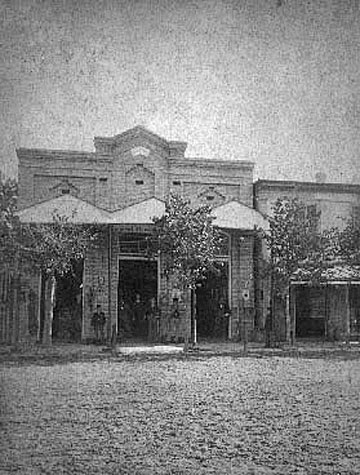 108 North Washington Street
108 North Washington Streetc. October 1886 to before May 1889
This address encompasses both buildings pictured. Both structures were built or used by A. E. Willenberg. The frame building may have been on site by 1886 when Mr. Willenberg conducted a general merchandise business in it. A frame building was on the site of the brick building until April 1886 when the frame was torn down to make way for A. E. Willenberg's new 28 X 85 foot red brick store. The new store had 15 foot high ceilings and a fire and burglar proof vault. Mr. Willenberg moved his store from the frame to the new brick in October 1886.
Mr. Willenberg died in 1888 and the buildings were rented out to many different businesses over the years. The frame building was torn down in the 1930's.
In 1939, the property was purchased by Will & August Hermes. They remodeled the brick and added on to it with a new building. Today the north wall is still visible between Schmidt Jewelry Store and the Hatfield Dental Clinic.
Known businesses until 1939: Willenberg's General Merchandise; Dr. G. W. Radford; B. F. Wilson; Ligon's County Seat Saloon; Dr. Murphey; Wells, Fargo & Co.; Ft. Worth Packery; M. Schlesinger dry goods; Racket Store; Simon & Rosenstein; Joe Kainer; E. J. McLean Millinery; Smith & Lidiak land agents; G. A. Tiemann bakery; La Grange Auto Sales; H. L. Koenecke laundry; Army Goods Store; E. J. Eck Shoe Shop; Grasshoff Meat Market; Spies Confectionery; Ed Schultz's Restaurant. Parade on North Washington Street
Parade on North Washington Streetca 1916-1919
 235, 237, 239 & 245 West Travis c.1909
235, 237, 239 & 245 West Travis c.1909The frame building on the left may have been the home of the "Live Oak Saloon" as early as 1840. Over the years it had many different tennants and was torn down in 1947 to make way for the current building, the home of Frank's Place.
Known businesses at 235 & 237 West Travis: Mattingly Millinery; F. W. Schmidt's Grocery Store; Frank Pratka's Saloon; Eck, Morris & Helms, barbers; Martin Bordovsky drink stand, cafe & confectionery; Louis Psencik, barber; Frank Mika, Frank's Place.
The center building was constructed in 1906 for the von Rosenberg-Heintze Company and housed their grocery, crockery & glass department. The building was "modern in appearance" with high ceilings and roller ladders.
Known businesses at 239 West Travis: von Rosenberg-Heintze grocery department; von Rosenberg Company grocery store; Von's Food Store; Koopman's Fodo Store; Schulze's Western Cafe; Granny's Room Antiques; Especially For You ladies clothing; Magic Moment.
The building on the right was known as the Farqhuar building as early as 1881 when it was the home of Carter & Hyde General Merchandise store. In 1890, C. J. von Rosenberg bought the building and had it renovated and fitted up for a "first class general merchandise" store.
The von Rosenberg-Heintze Company was formed in 1903 and the building was renovated once again. In 1922, this structure was torn down to make way for the present building.
Known businesses at 245 West Travis: Carter & Hyde; Mrs. Dabney, millinery; Hyde, Killough & Company; Taylor & Faires Company; C. J. von Rosenberg Company; von Rosenberg-Heintze Company; von Rosenberg Company; A. Skuy Department Store; Matocha's Paint & Hardware; Johnnie's Furniture Shop; Bill's Dollar Store; Tartan Discount Center; D & Z Men's Clothing Store.
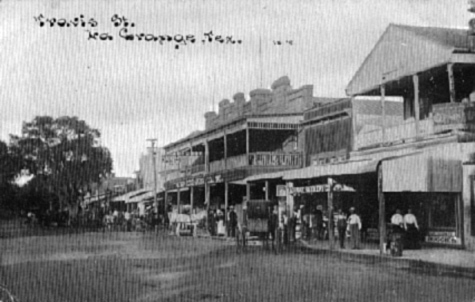 South Side of Square
South Side of Squareca 1909-1916
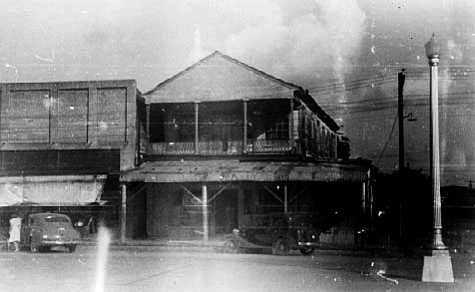 260 West Travis
260 West Travisca late 1940s
Somewhere between 1839 and 1844, Aaron A Gardiner & his partner Samuel Ward had this two story frame building erected on this lot. The lumber was sawed by hand under a large live oak tree that stood near the square. Gardiner was Fayette County Sheriff in 1844 & 1845. He died on June 12, 1845, after he fought a duel with rifles against Augustus Williams.
In 1881, the large general merchandise store of john H. Carter was located here. From 1909 to 1916, La Grange Saddlery did business in the building. They had an elevator installed and kept buggies on the second floor.
By 1938, Jake Palmer had a vegetable and fish market here.
In 1941, the structure was still standing and "tottering with age". It was torn down by 1950 and the lot has stood empty since.
 201 & 203 West Travis
201 & 203 West Travisca 1904-1911
"First load of turkeys from the von Rosenberg-Heintze Co. to the Jersig Produce Co."
The building pictured was on the square by the time of the Civil War, painted lue and Emil Richers conducted a mercantile business here. Thirty years later it was still referred to as the "Blue Store". In 1899, the building was "thoroughly overhauled" by F. C. Streithoff. The "Zur Gemütlichkeit", a saloon, was operating here by 1906. The building housed many businesses over the years and stood until September 1932.
 100 Block of West Travis
100 Block of West TravisSeptember 30, 1921
Funeral of Private H. J. Ehlers at the Presbyterian Church.
Hugo J. (Jimmy) Ehlers was killed in action on October 10, 1918 at St. Etienne, France, during World War I. News of his death reached La Grange on November 12, 1918, just one day after the armistice was signed. He was the only soldier from La Grange killed in WWI. It took nearly three years for his body to be returned home for burial.
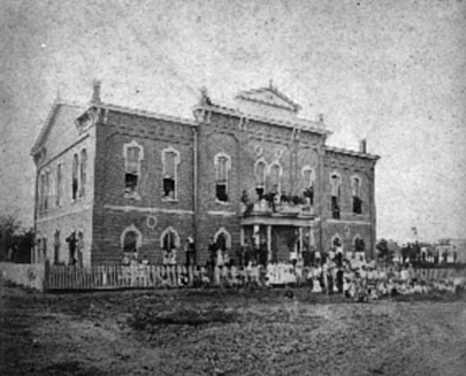 La Grange Casino Hall
La Grange Casino Hallca 1882 - 1890
The building was erected in 1881 by the La Grange Casino Society at a cost of nearly $13,000. It was constructed to be a theatre and ball room. By 1884, the building was being used for school purposes and served as the La Grange High School until 1923. The City of La Grange purchased the building and had its offices here until 1965 when the present City Hall was built. The La Grange Volunteer Fire Department also used the building from 1925 until 1992. The building has served as the Senior Citizens Activity Center since 1992.
 Railroad Depot
Railroad Depot161 West Lafayette
A rail passenger depot was first built on this site between 1885 and 1890. It was destroyed by fire in March 1897. This building was constructed in 1897 and served as a passenger depot for the M. K. & T. line until service ceased sometime in the 1940s. The railroad maintained an office here until the early 1908s. The front portion of the building was leased to a floral business, The Bloomin' Junction, in 1978. Known businesses: Bloomin' Junction; Bahnhof Gallery; La Grange Chamber of Commerce; Cutting Edge Beauty Salon; Trends Hair Salon. It's now the La Grange Railroad Museum.
The Museum Staff took on the task of creating the "Downtown Historic Building Survey" in the fall of 1996. The exhibit is the result of nearly a year of intensive research and documentation of the downtown buildings. Museum staff relied on the vast collections of local history in the Museum/Archives as well as asking the public for help with histories, photographs and memorabilia from businesses.
The first source of information examined was the Sanborn Fire Insurance Maps of La Grange beginning in 1885 and continuing through 1930. The fire insurance maps give you an excellent "footprint" of the buildings indicating their size, shape, & building material along with what type of business was utilizing the structures.
The main and most extensive source used were newspapers, chiefly the La Grange Journal which was published from 1880 until 1986. Photographs, both historic and current, were invaluable visual resources. In 1950, the City of La Grange instituted a property value re-assessment program wherein every taxable property was photographed and re-appraised.
Those photos and records are our best source of what La Grange looked like almost 50 years ago. In 1971, a local citizen photographed the downtown area and shared his results with us. Many turn of the century photographs also exist of our older buildings. Telephones directories, tax records, maps, obituaries existing building, business, and community histories and interviews were other sources used to compile the survey.
The survey covers 102 buildings in the downtown area. They are arranged by current street address and list, in most cases, the month and year of construction, who owned the property, who designed and built the structure along with what type of materials were used and the completion dates. Business and/or building owners and changes or additions made to them over the years are also included.
A project such as this is never truly complete. We ask our visitors to let us know if they have additional information or other photographs on any of the buildings in the exhibit We will be happy to add your information to ours.
Museum Staff: Kathy Carter, Margaret Huenefeld, Leslie Carpenter Schulze
Library Staff: Annette Ruckert & Sherie Knape
The following people and organizations made this exhibit possible: Museum League of Fayette County, Main Street La Grange Advisory Board, La Grange Chamber of Commerce, La Grange Volunteer Fire Department, Mark Carter, Georgia & John Denton, Elaine & Frank Giesber, Sandra & Don Hengst, Audrey Huenefeld, K. A. (Moe) Moellenberndt, Charles Plumlee, Daniel Rohan, Sue Romberg, Glen Roscher, Ora Lee Roscher, Shirley Schaeffer, Betty & Milton Schmidt, Erland & Mary Schulze, Tootsie Tiedt, Minnie Weber, Lola & Herb Whileyman, Anne Helen & W. A. Yates, and Dr. Leland Zatopek.
1880 Bird's-Eye View Map of La Grange
ssFeature at Amon Carter Museum web site shows all buildings and landscape
Early Businesses in La Grange
Includes La Grange Journal newspaper article from January 27, 1881 with annotations, along with postcards and information about more recent firms